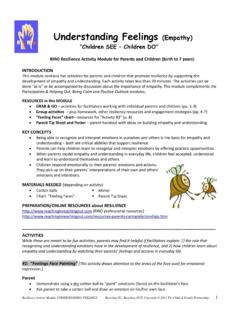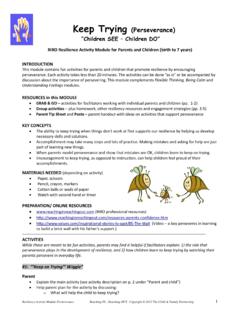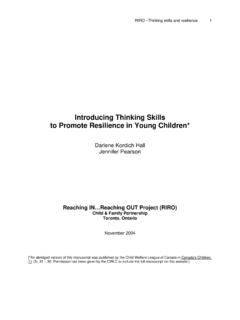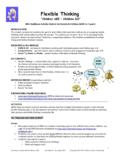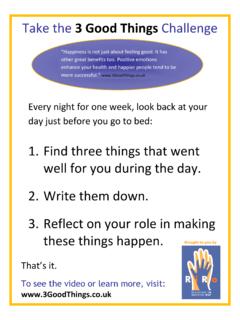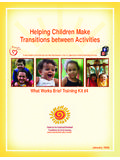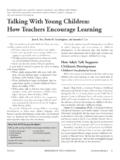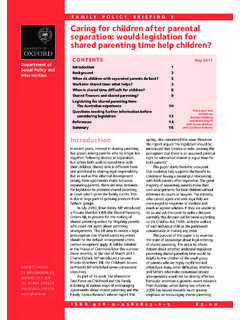Transcription of “Children SEE – Children DO”
1 1 Resiliency Activity Module-Being Calm Reaching OUT Copyright 2012 The Child & Family Partnership Being Calm Children SEE Children DO RIRO Resilience Activity Module for Parents & Children (birth to 7 years) INTRODUCTION This module contains fun activities for parents and Children that promote resilience by supporting the ability to calm oneself which leads to emotional regulation. Each activity takes less than 20 minutes. The activities can be done as is or be accompanied by discussion about the importance of calming. This module complements the Flexible Thinking, Positive Outlook and Understanding Feelings modules.
2 RESOURCES in this MODULE GRAB & GO activities for facilitators working with individual parents and Children (pp. 1-2) Group activities plus homework, other resiliency resources and engagement strategies (pp. 3-5) Parent Tip Sheet and Poster parent handout with ideas on participation and helping. KEY CONCEPTS Getting and staying calm is a skill that supports emotional regulation a critical ability that supports resilience. Parents can coach Children in deep breathing to relax themselves and gain control of their emotions. When parents model calmness in everyday life, Children learn how to get and stay calm. Children , as well as adults, respond to the emotions and reactions of those around them.
3 When adults remain calm, it helps Children become calm in the moment. MATERIALS NEEDED (depending on activity) Wads of paper of different sizes or cotton balls Bubble-making liquid and blower (see online for bubble making recipes) Parent T ip Sheet P R E PA RAT I O N/ ONLINE RESOURCES (RIRO professional resources) ---------------------------------------- ---------------------------------------- ---------------------------------------- --------------- ACTIVITIES While these are meant to be fun activities, parents may find it helpful if facilitators explain: 1) the role that calming has in the development of resilience, and 2) how Children learn about calming and regulating emotions by watching their parents calm down in everyday life.
4 #1: Three Deep Breaths Parent Show parent how to practice three deep breaths with full inhales and exhales. o Facilitator says: Breathe IN, 1, 2, 3; Breathe OUT, 1, 2, 3 and repeats several times. o Facilitator gradually lengthens the time between breaths by counting more slowly. Ask parent to speak (in front of the child) about what the parent is doing and then comment on the difference in his/her bodily tension level. 2 Resiliency Activity Module-Being Calm Reaching OUT Copyright 2012 The Child & Family Partnership Parent and Child Have parent face the child and take three deep breaths together. o Facilitator says: Breathe IN, 1, 2, 3; Breathe OUT, 1, 2, 3 and repeats several times.
5 O Then parent is asked to speak the words as child and parent practice breathing together. Note: Blowing on the child's cheek may help the child pace his/her breathing. #2: Cotton Ball Hockey Parent and Child Use a cotton ball (or small paper wad) as the puck. Direct the parent and child to blow the puck across the table or floor. Have parent and child play a hockey variant: Option 1: Parent and child can be across from each other and take turns trying to get a goal by blowing the puck into the other's hands (or other defined spot on opposite ends). Option 2: Parent and child can work together to blow puck toward a certain target.
6 (They can be next to each other, or across from each other, blowing toward a point away from them.) #3: Blowing a Balloon Parent / Parent and child Tell parent and/or child: o Pretend you are blowing up a balloon. o Start with arms at your side. o Make the bubble bigger and bigger with each breath and raise your arms over your head until they make a circle. o For the last breath, when your arms are in a big circle, give a BIG sigh as your arms go slowly down and your balloon deflates. #4: Parent and Infant Activities Parent and child Option 1: Ask parent to: o Hold infant on parent s chest and breathe slowly for two minutes. o Ask parent to notice if the infant becomes calmer.
7 Option 2: Ask parent to: o Breathe while looking into the infant s eyes. o Breathe out gently on different parts of the infant s body (hands, feet, tummy, cheeks, tops of the head) and then smile (for toddlers, you can also name the body parts). NOTE: Encourage parents to make sure that they and their Children get enough sleep. Research suggests that adding as little as a half hour to Children s sleep times can help increase self-regulation, alertness and school performance and decrease irritability, impulsiveness and restless behaviour. Here are some general guidelines for Children and adults: infants 14-16 hours, toddlers 12-14 hours, school-age 10-12 hours, teens 8-9 hours and adults 7-9 hours.
8 For more information, here are links for the Canadian Pediatric Society and the Mayo Clinic 3 Resiliency Activity Module-Being Calm Reaching OUT Copyright 2012 The Child & Family Partnership GROUP ACTIVITIES NOTE: These group activities are designed for professionals and paraprofessionals who have completed RIRO Resiliency Skills Training Program and who have group facilitation experience. Parent group (no Children present) Talk about the importance of controlled breathing in becoming and staying calm. Direct parents to notice their own tension levels. Then lead them through Three Deep Breaths exercise on pp. 1-2.
9 Ask them to notice the change in their tension level. Have group members discuss any differences they feel in their bodies. (optional) Facilitate discussion on different ways to help Children breathe deeply. Use parent examples and add other suggestions (see Take Home options). Emphasize the importance of deep breathing and role modeling it with Children . If time allows, and group is able, discuss situations where three deep breaths can help. Parent-child group Set up different stations with activities blow pretend balloons, bubbles or play cotton ball hockey. Have parent-child dyads rotate through the activities OR have parent-child dyads all do the same activity at the same time.
10 (Option 1 encourages movement and underlines that there are different choices at the same time, while Option 2 may have less potential for chaos!) While participants are doing the activities, facilitator may encourage parents to enjoy the activity, be aware of role modeling opportunities, and watch for how the Children respond (especially positive responses). After activities, make a statement about the importance of breathing in staying calm and thinking effectively. (Explain the physiological reason why breathing helps us calm down, if appropriate.) Have parents practice three deep breaths with their Children while facilitator points out how deep breathing calms us and what a difference just three breaths is making in the Children and parents.
